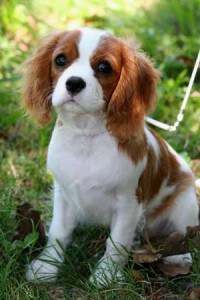From the desk of Sharda Baker
Good day and welcome everyone!
This is Sharda with another Adult Cavalier King Charles Spaniel newsletter.
So how do you spot a healthy Cavalier King Charles Spaniel?
Here we go!
Once you have decided on a Cavalier King Charles Spaniel, the next step is to determine which age, gender and temperament of dog or puppy that you would like.
In addition, if you are planning on showing the dog or have a particular color in mind, you may have additional requirements to choosing the right Cavalier for you and your family.
The most important consideration is if the dog or puppy is healthy.
Generally the Cavalier King Charles Spaniel is a sturdy and robust dog, and has few medical issues – provided it comes from a line that has no hereditary heart, eye or limb problems.
The conditions to look for are slightly different between a dog and a puppy, so each will be addressed separately below.
CHOOSING A HEALTH PUPPY
When first examining a Cavalier King Charles Spaniel puppy, there are several things to look for:
- The puppy should be generally alert and responsive to movement and sound. Jangling your car keys or clapping your hands away from the puppy should attract his or her attention. Don’t clap your hands directly in front of the puppy, as this can frighten them.
- The eyes should be clear and bright, with a moist but not teary surface. The eyes should not be protruding or sunken, but should be large and bright looking.
- The nose should be moist and soft, without any hard tissue or dry or scaly looking skin. There should be no discharge from the nose especially any that is cloudy or thick.
- The ears should be free of any wax build-up or discharge. This can easily be noted by simply and gently lifting the ear to expose the inside of the ear.
- The puppy should be naturally curious but not overly aggressive towards littermates. Initially, the puppy may be a bit nervous with new people, but this should end in a few minutes.
- Most puppies will not be sold before eight weeks, and some owners may wish to keep the puppies for twelve to sixteen weeks.
- The puppy should be of average weight without excessive fat. They should not be too thin either. Puppies that have a “pot belly” may have worms, so be sure to check if they have been properly cared for.
- The coat should be soft to the touch, and will be relatively short if the puppy is still fairly young. The coat will grow longer as the puppy matures.
- The kennel area should be clean, with good ventilation as well as fresh water available at all times. The puppies will usually be fed two or three times per day, and ask about the feeding schedule and type of food used.
- You should also request a vet check and a history of the female and male dog. This history should go back several generations, and should indicate that there are no hereditary disorders with the lines.
CHOOSING A HEALTHY ADULT DOG
Adult dogs should have the following physical and temperament traits:
- Clear eyes, that are moist but not tearing. There should be no staining under the eyes to indicate chronic irritation.
- The ears should be clean and without a waxy discharge. A discharge can be noted by a strong and unpleasant odor to the ears or the dogs head area.
- The dog should have a moderate length of coat that is free of tangles and knots or mats. There should be no “hot spots” or dry or irritated looking patches of skin on the dog.
- The Cavalier King Charles Spaniel should weigh between 13 and 18 pounds, and not be significantly overweight or underweight.
- The teeth should be straight and all present. There should be no inflammation of the gums or tarter build-up on the teeth. The breath should not be foul or rancid smelling, as this can indicate dental or gastrointestinal problems.
- The Cavalier may be somewhat aloof at first, but should quickly warm to people and enjoy been petted and praised. The dog should respond well to its owner.
- The Cavalier should not appear overly timid or aggressive towards new or familiar people, as this can be a sign that the dog has been mistreated in the past.
- The dog should be calm in the house, but should be willing and eager to go outside. It should be lively and alert looking, and very aware of the environment around.
As with puppies, it is important to find out if there are any genetic issues with the breeding line on either the mother or father’s side.
When buying a dog or a puppy, be sure to get the Cavalier to the vet as soon as possible for a complete check-up. Be sure to ask for the vaccination record from the previous owner or breeder, and keep all vaccinations current.
Also be aware that if you are transporting the dog or puppy to a new area, there may be additional vaccinations required.
I hope that you learned a lot from today’s Cavalier King Charles Spaniel newsletter
All the best and take care
Warmly,
Sharda Baker

